

Women are still sorely underrepresented in science globally, and there is a need to continue to #PressforProgress, including at ECMWF.
On the occasion of International Women’s Day, we look at the achievements of some of the women driving forward weather science at ECMWF.
Some of their career trajectories and current work are documented in a series of staff profile articles published on the ECMWF website:
 Ocean expert Magdalena Balmaseda is the Head of the Earth System Predictability Section in ECMWF’s Research Department.
Ocean expert Magdalena Balmaseda is the Head of the Earth System Predictability Section in ECMWF’s Research Department.
Her PhD and post-doctoral work was on dynamical systems, including the El Niño–Southern Oscillation (ENSO).
She has been closely involved in developing the use of ocean models at ECMWF. Read Magdalena’s account of how ocean modelling improves weather predictions.
 Sarah Keeley has been in charge of ECMWF’s numerical weather prediction (NWP) training programme since 2011.
Sarah Keeley has been in charge of ECMWF’s numerical weather prediction (NWP) training programme since 2011.
Like many of her colleagues in ECMWF’s Research Department, she did not initially train as a meteorologist but obtained a degree in physics and specialised in meteorology and climate science for her PhD.
Find out about her ideas on how to train the next generation of NWP experts.
 Anna Ghelli has been coordinating and managing activities for ECMWF Member and Co-operating States, such as the ECMWF annual user meeting (UEF), since 2012, and she manages training courses on the use of forecast products and software packages.
Anna Ghelli has been coordinating and managing activities for ECMWF Member and Co-operating States, such as the ECMWF annual user meeting (UEF), since 2012, and she manages training courses on the use of forecast products and software packages.
Discover how she moved into her current role of ECMWF’s International Liaison Officer in ECMWF’s Forecast Department after studying physics and specialising in the quality and reliability of meteorological observations.
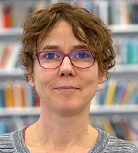 Patricia de Rosnay leads a team of scientists working to improve the way in which the Centre assimilates observations from interacting parts of the Earth system.
Patricia de Rosnay leads a team of scientists working to improve the way in which the Centre assimilates observations from interacting parts of the Earth system.
The seeds for a career in weather science were sown when, as a child, she used a rain gauge to measure the evolution of local precipitation rates.
Read her account of how land surface observations improve weather forecasts.
 Emma Pidduck works in ECMWF’s Data Services team.
Emma Pidduck works in ECMWF’s Data Services team.
As a scientist with a degree in ocean science and a PhD in estuarine physical oceanography and marine geochemistry, she has the necessary know-how to communicate with the full range of non-Member and Co-operating State users interested in ECMWF’s data.
Find out how Emma supports data users in WMO countries, research and business.
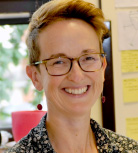 Sarah-Jane Lock did a PhD in microscale atmospheric dynamics and postdoctoral work on numerical methods for NWP after a first degree in maths and physics.
Sarah-Jane Lock did a PhD in microscale atmospheric dynamics and postdoctoral work on numerical methods for NWP after a first degree in maths and physics.
This wide range of experience came in handy in 2013, when she joined ECMWF’s Research Department to work on model uncertainty in ensemble forecasts.
Discover what her work on pinning down uncertainty in weather forecasting involves.
Communicating science
Many women scientists at ECMWF regularly use their expertise to communicate weather and climate science to a broader audience:
 Florence Rabier has been Director-General of ECMWF since January 2016.
Florence Rabier has been Director-General of ECMWF since January 2016.
She is an internationally recognised expert in numerical weather prediction and is especially well known within the meteorological community for her key role in implementing a new data assimilation method, 4D-Var, in 1997.
Watch a video in which Florence and colleagues explain the rationale behind the 4D-Var method.
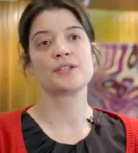 Freja Vamborg joined the EU-funded Copernicus Climate Change Service (C3S) being implemented by ECMWF as a Senior Climate Scientist in 2017.
Freja Vamborg joined the EU-funded Copernicus Climate Change Service (C3S) being implemented by ECMWF as a Senior Climate Scientist in 2017.
Previously she worked at the Max Planck Institute for Meteorology in Germany for 10 years.
She is particularly active in communicating climate science, as exemplified by a video in which Freja and colleagues present C3S climate data for 2017.
 Francesca Di Giuseppe is a scientist in ECMWF’s Forecast Department.
Francesca Di Giuseppe is a scientist in ECMWF’s Forecast Department.
In a recent blog post, she explains how she has helped to develop the fire danger modelling infrastructure at ECMWF, and she discusses some of the unique challenges involved in predicting this hazard.
She has also authored recent ECMWF Newsletter articles on wildfires in Portugal and the August 2017 heat wave in southern Europe.
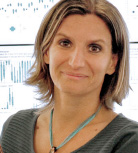 Irina Sandu leads a team of scientists in ECMWF’s Research Department working on physical processes.
Irina Sandu leads a team of scientists in ECMWF’s Research Department working on physical processes.
In a recent Newsletter feature article, she explains the impact of the drag exerted by topography on forecast skill. In a web article on Earth surface effects on atmospheric flow, she describes the physical processes involved and how they are modelled in numerical weather prediction.
Irina's work on these aspects was recognised through the WCRP/WWRP International Prize for Model Development 2016.
 Rossana Dragani is a scientist in ECMWF’s Research Department who specialises in atmospheric composition.
Rossana Dragani is a scientist in ECMWF’s Research Department who specialises in atmospheric composition.
In a recent Newsletter feature article, she describes ECMWF’s role in the EU-funded AURORA project.
The project is exploring new ways of exploiting the high-resolution data that will be provided with unprecedented accuracy by the Copernicus Sentinel-4 (S4), -5 (S5) and -5P (S5P) satellites.
 Fatima Pillosu is a scientist in the applications team in ECMWF’s Forecast Department.
Fatima Pillosu is a scientist in the applications team in ECMWF’s Forecast Department.
In a recent Newsletter article, she explains how a new probabilistic point-rainfall product could support the prediction of flash floods across the globe.
In another article, she describes how in 2017 ECMWF provided Peru with forecast products to help the country deal with exceptionally heavy rainfall.
Of course, many more women work in weather science at ECMWF and regularly share their expertise in our publications and at the workshops and training events we run at the Centre.
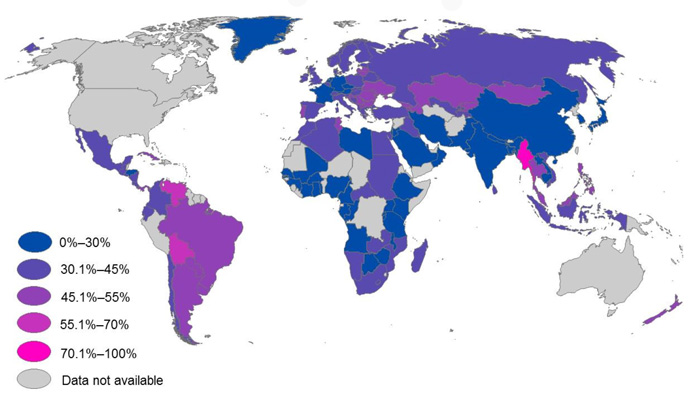
Women as a share of total researchers, 2014 or latest year available. (Source: UNESCO Institute for Statistics, Women in Science – 2017 factsheet).
